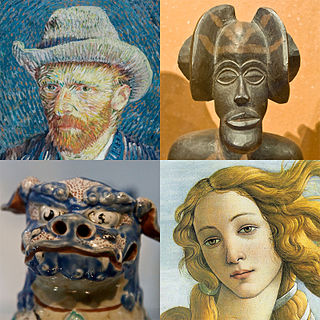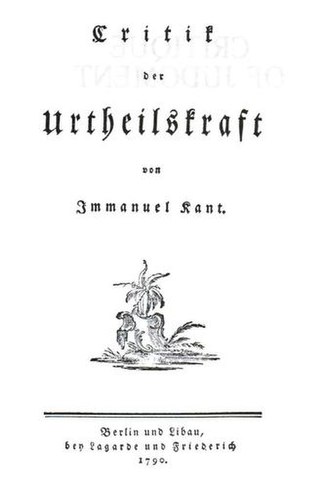Related Research Articles

Art is a diverse range of human activity and its resulting product that involves creative or imaginative talent generally expressive of technical proficiency, beauty, emotional power, or conceptual ideas.
Aesthetics is the branch of philosophy concerned with the nature of beauty and the nature of taste; and functions as the philosophy of art. Aesthetics examines the philosophy of aesthetic value, which is determined by critical judgements of artistic taste; thus, the function of aesthetics is the "critical reflection on art, culture and nature".

Immanuel Kant was a German philosopher and one of the central Enlightenment thinkers. Born in Königsberg, Kant's comprehensive and systematic works in epistemology, metaphysics, ethics, and aesthetics have made him one of the most influential and controversial figures in modern Western philosophy, being called the "father of modern ethics", the "father of modern aesthetics", and for bringing together rationalism and empiricism earned the title of "father of modern philosophy".
Defamiliarization or ostranenie is the artistic technique of presenting to audiences common things in an unfamiliar or strange way so they could gain new perspectives and see the world differently. According to the Russian formalists who coined the term, it is the central concept of art and poetry. The concept has influenced 20th-century art and theory, ranging over movements including Dada, postmodernism, epic theatre, science fiction, and philosophy; additionally, it is used as a tactic by recent movements such as culture jamming.
The term formalism describes an emphasis on form over content or meaning in the arts, literature, or philosophy. A practitioner of formalism is called a formalist. A formalist, with respect to some discipline, holds that there is no transcendent meaning to that discipline other than the literal content created by a practitioner. For example, formalists within mathematics claim that mathematics is no more than the symbols written down by the mathematician, which is based on logic and a few elementary rules alone. This is as opposed to non-formalists, within that field, who hold that there are some things inherently true, and are not, necessarily, dependent on the symbols within mathematics so much as a greater truth. Formalists within a discipline are completely concerned with "the rules of the game," as there is no other external truth that can be achieved beyond those given rules. In this sense, formalism lends itself well to disciplines based upon axiomatic systems.

The Critique of Pure Reason is a book by the German philosopher Immanuel Kant, in which the author seeks to determine the limits and scope of metaphysics. Also referred to as Kant's "First Critique", it was followed by his Critique of Practical Reason (1788) and Critique of Judgment (1790). In the preface to the first edition, Kant explains that by a "critique of pure reason" he means a critique "of the faculty of reason in general, in respect of all knowledge after which it may strive independently of all experience" and that he aims to reach a decision about "the possibility or impossibility of metaphysics". The term "critique" is understood to mean a systematic analysis in this context, rather than the colloquial sense of the term.
Russian formalism was a school of literary theory in Russia from the 1910s to the 1930s. It includes the work of a number of highly influential Russian and Soviet scholars such as Viktor Shklovsky, Yuri Tynianov, Vladimir Propp, Boris Eichenbaum, Roman Jakobson, Boris Tomashevsky, Grigory Gukovsky who revolutionised literary criticism between 1914 and the 1930s by establishing the specificity and autonomy of poetic language and literature. Russian formalism exerted a major influence on thinkers like Mikhail Bakhtin and Juri Lotman, and on structuralism as a whole. The movement's members had a relevant influence on modern literary criticism, as it developed in the structuralist and post-structuralist periods. Under Stalin it became a pejorative term for elitist art.
Critique is a method of disciplined, systematic study of a written or oral discourse. Although critique is commonly understood as fault finding and negative judgment, it can also involve merit recognition, and in the philosophical tradition it also means a methodical practice of doubt. The contemporary sense of critique has been largely influenced by the Enlightenment critique of prejudice and authority, which championed the emancipation and autonomy from religious and political authorities.

Transcendental idealism is a philosophical system founded by German philosopher Immanuel Kant in the 18th century. Kant's epistemological program is found throughout his Critique of Pure Reason (1781). By transcendental Kant means that his philosophical approach to knowledge transcends mere consideration of sensory evidence and requires an understanding of the mind's innate modes of processing that sensory evidence.

The Critique of Judgment, also translated as the Critique of the Power of Judgment, is a 1790 book by the German philosopher Immanuel Kant. Sometimes referred to as the "third critique", the Critique of Judgment follows the Critique of Pure Reason (1781) and the Critique of Practical Reason (1788).
Absolute music is music that is not explicitly "about" anything; in contrast to program music, it is non-representational. The idea of absolute music developed at the end of the 18th century in the writings of authors of early German Romanticism, such as Wilhelm Heinrich Wackenroder, Ludwig Tieck and E. T. A. Hoffmann but the term was not coined until 1846 where it was first used by Richard Wagner in a programme to Beethoven's Ninth Symphony.

Aesthetics of music is a branch of philosophy that deals with the nature of art, beauty and taste in music, and with the creation or appreciation of beauty in music. In the pre-modern tradition, the aesthetics of music or musical aesthetics explored the mathematical and cosmological dimensions of rhythmic and harmonic organization. In the eighteenth century, focus shifted to the experience of hearing music, and thus to questions about its beauty and human enjoyment of music. The origin of this philosophic shift is sometimes attributed to Baumgarten in the 18th century, followed by Kant.
Formalism is a school of literary criticism and literary theory having mainly to do with structural purposes of a particular text. It is the study of a text without taking into account any outside influence. Formalism rejects or sometimes simply "brackets" notions of culture or societal influence, authorship, and content, and instead focuses on modes, genres, discourse, and forms.
Ethical formalism is a type of ethical theory which defines moral judgments in terms of their logical form rather than their content. The term also often carries critical connotations. Kant, for example, has been criticized for defining morality in terms of the formal feature of being a "universal law", and then attempting to derive from this formal feature various concrete moral duties.
A coordinative definition is a postulate which assigns a partial meaning to the theoretical terms of a scientific theory by correlating the mathematical objects of the pure or formal/syntactical aspects of a theory with physical objects in the world. The idea was formulated by the logical positivists and arises out of a formalist vision of mathematics as pure symbol manipulation.

In Kantian philosophy, a transcendental schema is the procedural rule by which a category or pure, non-empirical concept is associated with a sense impression. A private, subjective intuition is thereby discursively thought to be a representation of an external object. Transcendental schemata are supposedly produced by the imagination in relation to time.
Galvano Della Volpe was an Italian professor of philosophy and Marxist theorist.
In the philosophy of mathematics, formalism is the view that holds that statements of mathematics and logic can be considered to be statements about the consequences of the manipulation of strings using established manipulation rules. A central idea of formalism "is that mathematics is not a body of propositions representing an abstract sector of reality, but is much more akin to a game, bringing with it no more commitment to an ontology of objects or properties than ludo or chess." According to formalism, the truths expressed in logic and mathematics are not about numbers, sets, or triangles or any other coextensive subject matter — in fact, they aren't "about" anything at all. Rather, mathematical statements are syntactic forms whose shapes and locations have no meaning unless they are given an interpretation. In contrast to mathematical realism, logicism, or intuitionism, formalism's contours are less defined due to broad approaches that can be categorized as formalist.
A theory of art is intended to contrast with a definition of art. Traditionally, definitions are composed of necessary and sufficient conditions and a single counterexample overthrows such a definition. Theorizing about art, on the other hand, is analogous to a theory of a natural phenomenon like gravity. In fact, the intent behind a theory of art is to treat art as a natural phenomenon that should be investigated like any other. The question of whether one can speak of a theory of art without employing a concept of art is also discussed below.
Nick Zangwill is a British philosopher and honorary research professor at University College London and Lincoln University. He is known for his expertise on moral philosophy, and aesthetics.
References
- ↑ Kant. Critique of Judgment. Section 14.8.
- ↑ Donald Crawford, Kant's Aesthetic Theory (Madison: The University of Wisconsin Press, 1974), p. 100.
- ↑ Nick Zangwill, The Metaphysics of Beauty (Ithaca, NY: Cornell University Press, 2001), p. 56, ISBN 0801438209.
- ↑ Branko Mitrović, Philosophy for architects (New York: Princeton Architectural Press, [2011]), p. 51.
- 1 2 Zangwill 2001, p. 84.
- ↑ Gal, Michalle (2015). Aestheticism: Deep Formalism and the Emergence of Modernist Aesthetics. Peter Lang AG. p. 14. doi:10.3726/978-3-0351-0787-6. ISBN 9783035199925.
- ↑ Review by: Clemency Chase Coggins of The Uses of Style in Archaeology edited by Margaret W. Conkey and Christine A. Hastorf, p. 233, Journal of Field Archaeology, Vol. 19, No. 2 (Summer, 1992), pp. 232–34, Maney Publishing, JSTOR